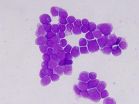(Press-News.org) Men taking androgen deprivation therapy (ADT) for prostate cancer may have an increased risk of colorectal cancer, according to a study published online November 10 in The Journal of the National Cancer Institute.
Androgen deprivation therapy is a widely-prescribed treatment in men with prostate cancer, although its usage for low-risk disease remains controversial, given the adverse side effects, including osteoporosis, cardiovascular disease, diabetes and obesity; the last two are risk factors for colorectal cancer.
To determine whether prostate cancer patients taking androgen deprivation therapy are at an increased risk of colon cancer, Silke Gillessen, M.D., of the Cantonal Hospital in St. Gallen, Switzerland, and colleagues, did an observational study of men with prostate cancer identified through the Surveillance, Epidemiology, and End Results (SEER) database of the National Cancer Institute. Specifically, they identified 107,859 men aged 67 years or older who were diagnosed with prostate cancer between 1993 and 2002, with follow-up through 2004. The men received the ADT either in the form of gonadotropin-releasing hormone (GnRH) agonists, or an orchiectomy.
The researchers found that after adjustment for confounding variables such as age and socio-economic status, there was a 30-40% relative increase in the rate of colorectal cancer among the men treated with ADT compared with those who were not. Furthermore, the longer the men took ADT, the greater their risk of developing colorectal cancer. However, further study would be needed to determine the risk with treatment over longer periods than could be observed in this study.
The authors write that the study results could have "important implications" for men with prostate cancer taking ADT, especially those with localized, slow-growing disease, for whom the duration of ADT is generally longer.
In an accompanying editorial, Jennifer H. Lin, Ph.D., and Edward Giovannucci, M.D., of Brigham and Women's Hospital in Boston write that the study shows that an elevated risk of colorectal cancer may be an additional consideration in the decision to use ADT, especially given the side effects and their effect on quality of life.
INFORMATION:
Contact:
Article: Nicole Fawcett, Media Contact, University of Michigan, nfawcett@med.umich.edu, 734-764-2220
Editorial: Jennifer Hsiang-Ling Lin, Ph.D., Brigham and Women's Hospital, 617-278- 0894 jhlin@rics.bwh.harvard.edu
Think New York is an exceptional city? It's not. The Big Apple is just about average for a city of its size. However, San Francisco is exceptional. Its inhabitants are wealthier, more productive, more innovative, and subject to fewer crimes than you would expect, given its size.
Turns out many of the cities we typically think of as great ones probably wouldn't show up near the top of most rankings, if Luis Bettencourt of the Santa Fe Institute has his way. He and his colleagues believe traditional per-capita measures are not very useful for determining what makes one ...
Obstetricians and midwives should wait a few minutes before clamping the umbilical cords of newborn infants so that babies are not harmed by the procedure, argues Dr David Hutchon in an article published on bmj.com today.
Hutchon, a retired consultant obstetrician from the Memorial Hospital in Darlington, says it's time for the UK to follow guidance from the World Health Organisation and the International Federation of Gynaecology and Obstetrics and refrain from early cord clamping.
Despite evidence for the benefit of delayed cord clamping, clinicians in the UK seem ...
AUDIO:
Researchers at Washington University in St. Louis have identified mutations in a single gene that are associated with a poor prognosis for patients with acute myeloid leukemia. The discovery suggests...
Click here for more information.
Decoding the DNA of a woman who died of acute myeloid leukemia (AML) has led researchers at Washington University School of Medicine in St. Louis to a gene that they found to be commonly altered in many patients who died quickly of ...
Researchers have discovered mutations in a particular gene that affects the treatment prognosis for some patients with acute myeloid leukemia (AML), an aggressive blood cancer that kills 9,000 Americans annually. The scientists report their results in the Nov. 11, 2010, on-line issue of The New England Journal of Medicine.
The Washington University School of Medicine in St. Louis team initially discovered a mutation by completely sequencing the genome of a single AML patient. They then used targeted DNA sequencing on nearly 300 additional AML patient samples to confirm ...
An Australian research team from the Peter MacCallum Cancer Centre, the University of Melbourne and the University of Queensland has identified a new risk factor for developing breast cancer. This has been published online in the journal Cancer Prevention Research.
The risk factor involves a modification (DNA methylation) to the BRCA1 gene. BRCA1 is known for its involvement in breast and ovarian cancer. Women with mutations in this gene, which inactivates its function, are predisposed to these diseases.
The DNA methylation modification is known as an epimutation and ...
Variations in atmosphere carbon dioxide around 40 million years ago were tightly coupled to changes in global temperature, according to new findings published in the journal Science. The study was led by scientists at Utrecht University, working with colleagues at the NIOZ Royal Netherlands Institute for Sea Research and the University of Southampton.
"Understanding the relationship between the Earth's climate and atmospheric carbon dioxide in the geological past can provide insight into the extent of future global warming expected to result from carbon dioxide emission ...
How well a person performs in a coalition is partly hereditary, according to a recent study.
Researchers found that how successfully an individual operates in a group is as much down to having the right genetic make-up as it is to having common cultural ties with fellow group members.
After assessing nearly 1000 pairs of adult twins, researchers at the University of Edinburgh found that strong genetic influences have a major influence on how loyal a person feels to their social group.
It also has a significant impact on how flexibly they can adapt group membership.
Family ...
Evidence suggesting that the risk of childhood asthma associated with prenatal paracetamol exposure may depend on antioxidant genes in the mother has been found by a team of UK scientists. The results of their study - which strengthens the argument for a causal link between paracetamol exposure in early life and later childhood asthma - are published online (10 November) in the Journal of Allergy and Clinical Immunology.
Led by Seif Shaheen, Professor of Respiratory Epidemiology at Barts and The London School of Medicine and Dentistry, the team examined data from the ...
New ultra-clean nanowires produced at the Nano-Science Center, University of Copenhagen will have a central role in the development of new high-efficiency solar cells and electronics on a nanometer scale. PhD student Peter Krogstrup, Niels Bohr Institute, in collaboration with a number of well-known researchers and the company SunFlake A/S, is behind the breakthrough. The new findings have recently been published in the prestigious journal Nano Letters.
Nanowires are one-dimensional structures with unique electrical and optical properties – a kind of building blocks, ...
A new Reference Report published today by the European Commission's Joint Research Centre (JRC) lists 79 reference methods for GMO analysis which have been validated according to international standards. This Compendium, developed jointly by the European Union Reference Laboratory for Genetically Modified Food and Feed (EU-RL GMFF) and the European Network of GMO Laboratories (ENGL), presents the technical state of the art in GMO detection methods. Each method is described in a user-friendly way, facilitating the implementation of GMO legislation by official control bodies.
Presenting ...

